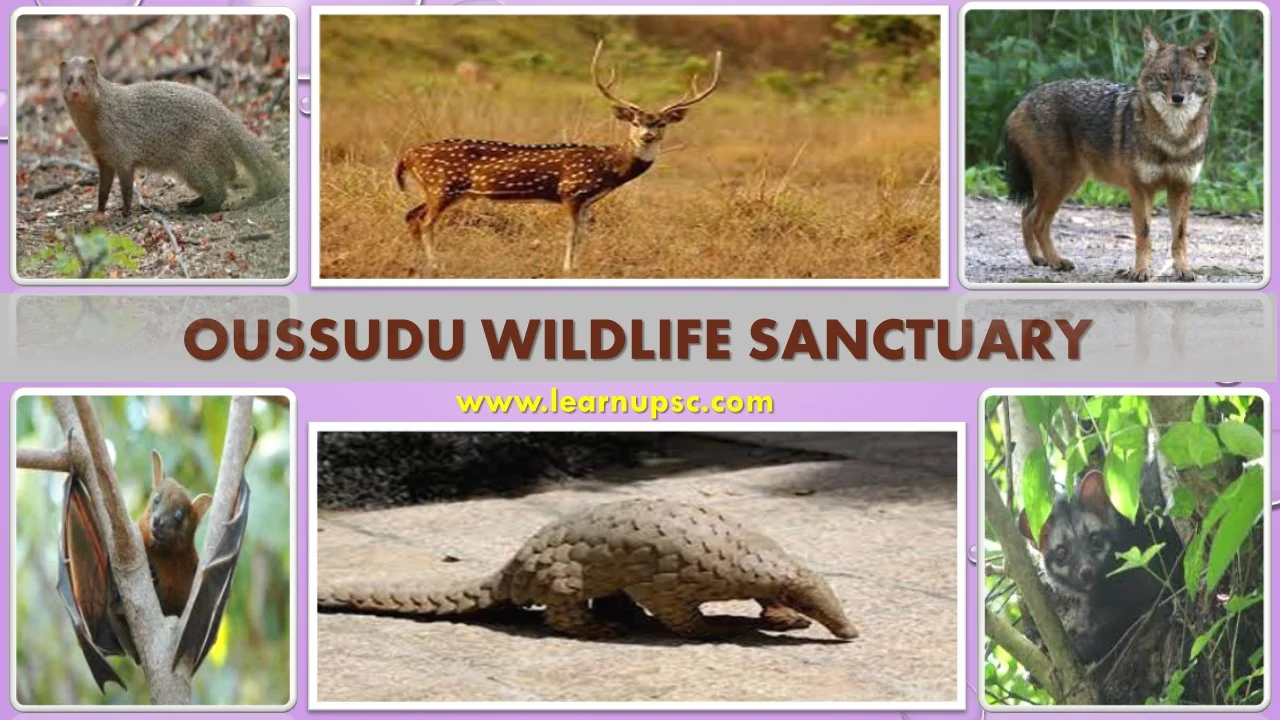Oussudu Wildlife Sanctuary UPSC
The Oussudu Wildlife Sanctuary is a protected area located in the Union Territory of Puducherry, India. The sanctuary is primarily focused on the conservation of wetland ecosystems and the diverse birdlife that depends on them.
The sanctuary is centered around the Oussudu Lake, a seasonal freshwater wetland. This lake is a crucial stopover point for numerous migratory bird species during their annual migrations.
Apart from birds, the sanctuary is also home to various other forms of wildlife, such as amphibians, reptiles, and small mammals. The surrounding vegetation includes marshy areas, reed beds, and aquatic plants that provide important habitats for these species.
|
Table of Contents
|
Oussudu Wildlife Sanctuary Location
The Oussudu Wildlife Sanctuary is located in the Union Territory of Puducherry, India. Specifically, it is situated near the town of Villianur, which is approximately 10 kilometers from the city of Puducherry (formerly known as Pondicherry).
The sanctuary encompasses the Ousteri Lake and the surrounding areas, making it a notable natural area for wildlife conservation and birdwatching in the region.
Oussudu Wildlife Sanctuary Nearest Airport:
Lawspet, Puducherry Airport (also known as Puducherry Airport) is the nearest airport to the Oussudu Wildlife Sanctuary. It is located approximately 12 kilometers away from the sanctuary.
Oussudu Wildlife Sanctuary Nearest Railway Station:
Puducherry Railway Station, situated in the city of Puducherry, is the closest railway station to the Oussudu Wildlife Sanctuary. It is located approximately 13 kilometers from the sanctuary
Oussudu Wildlife Sanctuary History
Establishment: The sanctuary was officially notified on 7th October 2008, which marked the formal recognition of its importance for wildlife conservation.
Migratory Bird Importance: Given the sanctuary's significance as a wetland habitat and its recognition by the International Union for Conservation of Nature (IUCN) as one of the most important wetlands in Asia, efforts may have been made to raise awareness about its importance for migratory birds and other wildlife.
Oussudu Wildlife Sanctuary Area
The Oussudu Wildlife Sanctuary covers an approximate area of 3.90 square kilometers or 390 hectares. This area includes the Ousteri Lake and the surrounding natural landscapes, making it a significant region for wildlife conservation and biodiversity protection in the region.
Oussudu Wildlife Sanctuary Lake
The Oussudu Wildlife Sanctuary features the Ousteri Lake (also spelled as Oussudu Lake), which is a prominent and central component of the sanctuary. The lake is a crucial part of the sanctuary's ecosystem and plays a vital role in supporting a diverse range of flora and fauna, particularly birdlife.
The Ousteri Lake is a seasonal freshwater wetland that expands during the monsoon season and contracts during the dry months. It is recognized as one of the most important wetlands in Asia by the International Union for Conservation of Nature (IUCN). The lake's wetland habitat is a significant attraction for various migratory bird species, making it a popular destination for birdwatching.
During the winter months, numerous migratory birds from different parts of the world, including Siberia and Europe, visit the Ousteri Lake for breeding, feeding, and resting. This seasonal influx of birdlife contributes to the sanctuary's status as an important bird conservation area.
The presence of the Ousteri Lake and its surrounding wetlands and vegetation adds to the natural beauty and ecological significance of the Oussudu Wildlife Sanctuary, making it an ideal location for nature enthusiasts and birdwatchers.
Oussudu Wildlife Sanctuary Flora
The Oussudu Wildlife Sanctuary hosts a diverse range of flora, which contributes to the overall biodiversity and ecological significance of the sanctuary.
Here is a list of flora that are found in the Oussudu Wildlife Sanctuary:
- Acacia auriculiformis
- Azadirachta indica (Neem)
- Bombax ceiba (Silk Cotton Tree)
- Borassus flabellifer (Palmyra Palm)
- Ceiba pentandra
- Dalbergia paniculata
- Ficus benghalensis (Banyan)
- Ficus religiosa (Peepal)
- Gmelina arborea
- Abutilon hirtum
- Abutilon indicum
- Barleria cristata
- Calotropis gigantea
- Cassia auriculata
- Ficus hispida
- Flueggea leucopyrus
- Jatropha gossypifolia
- Jatropha tanjorensis
- Lantana camara
- Cissus trifoliata
- Cissus vitiginea
- Chloris barbata
- Chrysopogon asper
Oussudu Wildlife Sanctuary Fauna (Oussudu Wildlife Sanctuary Animals)
Here is a list of fauna found in the Oussudu Wildlife Sanctuary:
Mammals:
- Spotted Deer
- Golden Jackal
- Jungle Cat
- Grey Mongoose
- Indian Hare
- Asian Palm Civet
- Short-nosed Fruit Bat
- Indian Pangolin
Birds:
- Great White Pelican
- Greater Flamingo
- Lesser Flamingo
- Crested Serpent Eagle
- White-bellied Sea Eagle
- Bay-backed Shrike
- Southern Grey Shrike
- Black-hooded Oriole
- Rosy Starling
Reptiles:
- Indian Black Turtle
- Brahminy Worm Snake
- Indian Rock Python
- Common Vine Snake
- Indian Wolf Snake
- Garden Lizard
- Indian Monitor Lizard
Oussudu Wildlife Sanctuary UPSC Questions
Q. Where is Oussudu Wildlife Sanctuary?
A. The Oussudu Wildlife Sanctuary is located near the town of Villianur, which is approximately 10 kilometers from the city of Puducherry (formerly known as Pondicherry), in the Union Territory of Puducherry, India. This sanctuary encompasses the Ousteri Lake and its surrounding areas, making it an important site for wildlife conservation and natural beauty in the region.


No comments:
Post a Comment